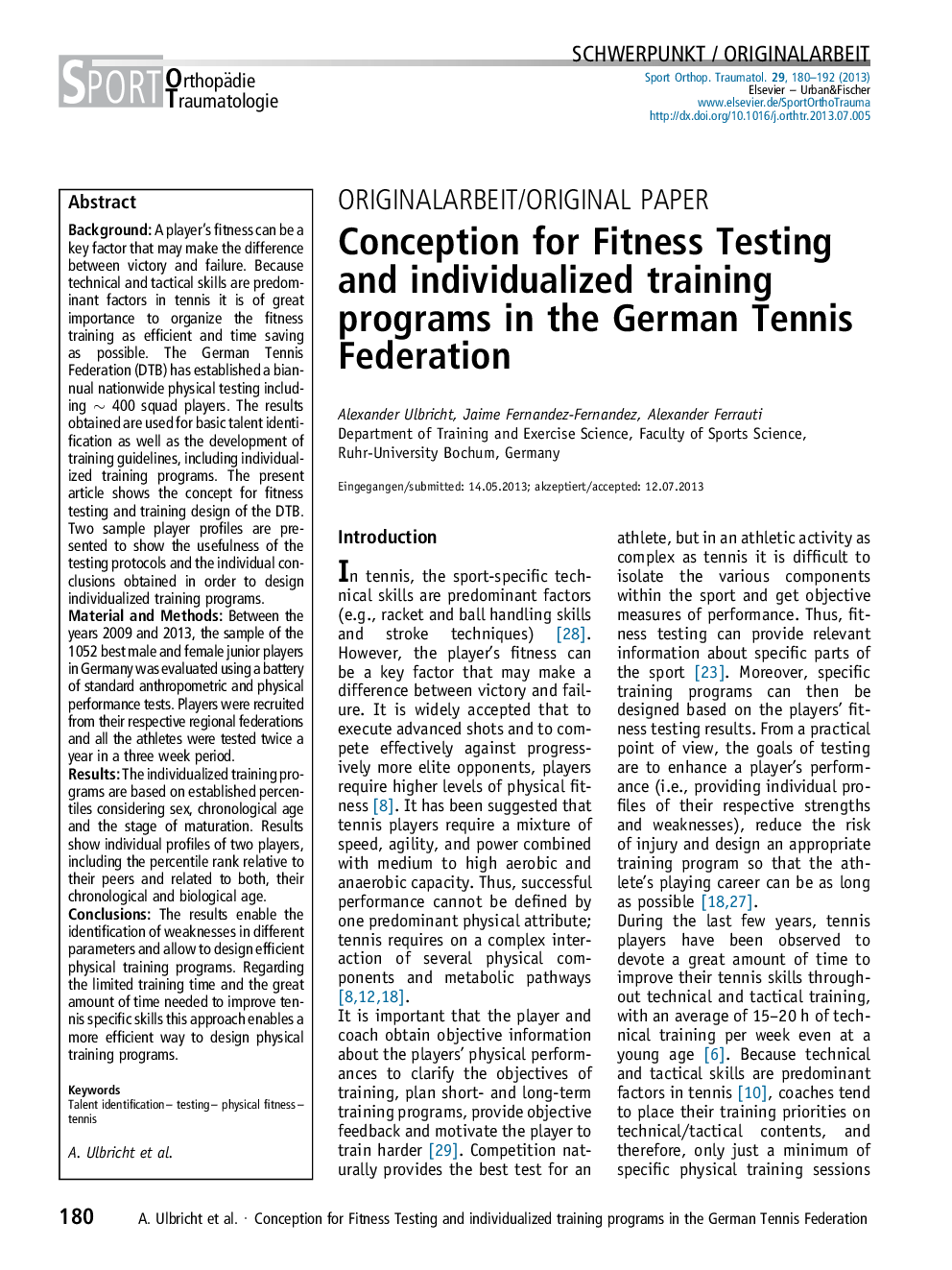| Article ID | Journal | Published Year | Pages | File Type |
|---|---|---|---|---|
| 2740383 | Sports Orthopaedics and Traumatology | 2013 | 13 Pages |
ZusammenfassungHintergrundIm modernen Leistungstennis gewinnt die Athletik zunehmend an Bedeutung, obwohl Technik und Taktik nach wie vor primär leistungslimitierend sind. Folglich sollte das Konditionstraining möglichst individualisiert und dadurch ressourcensparend sein. Der Deutsche Tennis Bund betreibt seit vier Jahren eine konditionelle Leistungsdiagnostik mit allen Kaderspielern auf dessen Grundlage individuell angepasste Trainingsempfehlungen gegeben werden. Der vorliegende Beitrag beschreibt die Durchführung der Testbatterie und verdeutlicht anhand von zwei Fallbeispielen den Wert von differenzierten leistungsdiagnostischen Befunden für eine individuelle zielgerichtete Ausrichtung des Konditionstrainings.MethodenIm Zeitraum von 2009-2013 nahmen 1052 männliche und weibliche C-/D-Kaderspieler im Alter von 10 bis 18 Jahren am „DTB-Konditionstest“ teil. Dieser beinhaltet standardisierte anthropometrische und konditionelle Untersuchungen.ResultateGrundlage der individuellen Leistungssteuerung ist der Vergleich der Individualbefunde mit alters-, geschlechts- und entwicklungsrelativierten Normprofilen, deren Anwendung anhand von zwei Beispielen verdeutlicht wird. Die entwickelten Normprofile basieren auf Halbjahresgruppierungen und berücksichtigen sowohl das chronologische als auch das biologische Alter.SchlussfolgerungenDie Fallbeispiele verdeutlichen die Notwendigkeit entwicklungsrelativierter Normprofile für eine individuelle, zielgerichtete Ausrichtung des Konditionstrainings. Auf der Grundlage der Ergebnisse werden eindeutige Stärken und Schwächen in den unterschiedlichen motorischen Hauptfaktoren deutlich gemacht, so kann eine klare Schwerpunktsetzung für das Training empfohlen werden.
BackgroundA player's fitness can be a key factor that may make the difference between victory and failure. Because technical and tactical skills are predominant factors in tennis it is of great importance to organize the fitness training as efficient and time saving as possible. The German Tennis Federation (DTB) has established a biannual nationwide physical testing including ∼ 400 squad players. The results obtained are used for basic talent identification as well as the development of training guidelines, including individualized training programs. The present article shows the concept for fitness testing and training design of the DTB. Two sample player profiles are presented to show the usefulness of the testing protocols and the individual conclusions obtained in order to design individualized training programs.Material and MethodsBetween the years 2009 and 2013, the sample of the 1052 best male and female junior players in Germany was evaluated using a battery of standard anthropometric and physical performance tests. Players were recruited from their respective regional federations and all the athletes were tested twice a year in a three week period.ResultsThe individualized training programs are based on established percentiles considering sex, chronological age and the stage of maturation. Results show individual profiles of two players, including the percentile rank relative to their peers and related to both, their chronological and biological age.ConclusionsThe results enable the identification of weaknesses in different parameters and allow to design efficient physical training programs. Regarding the limited training time and the great amount of time needed to improve tennis specific skills this approach enables a more efficient way to design physical training programs.
